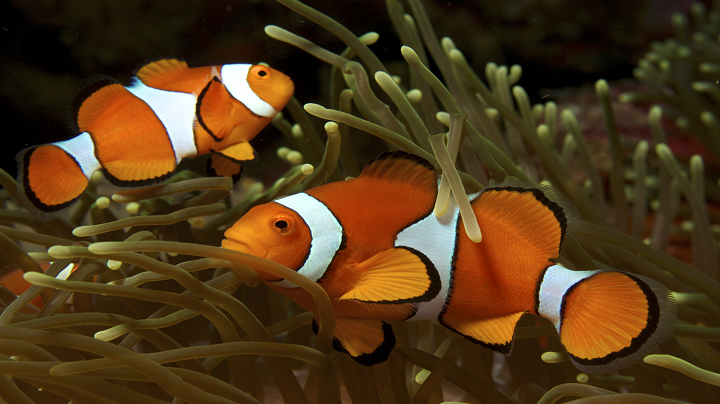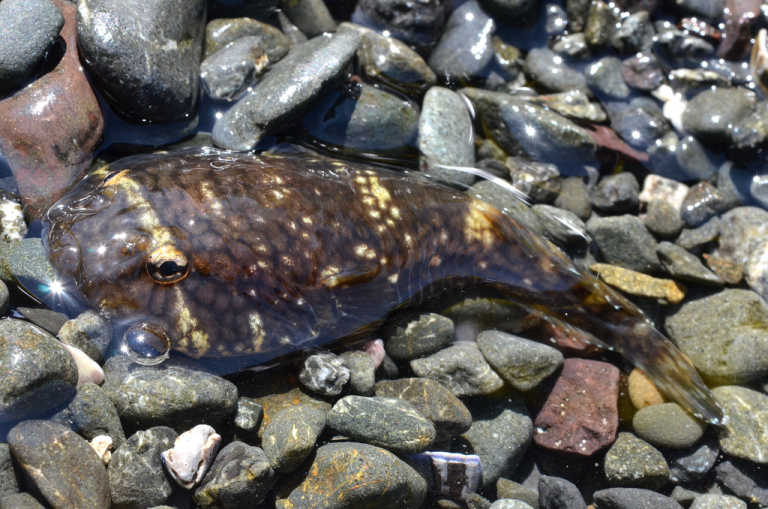The Asian Sheepshead Wrasse (Semicossyphus reticulatus) is a species of marine fish that resides in parts of the western Pacific Ocean. This species of wrasse is found predominantly in Japan, China, South Korea, and North Korea, with some other records from Russia and Taiwan.
Though they are often found in shallow waters near the shoreline, sometimes being seen by divers or snorkelers, they can also inhabit deeper areas within the ocean.
Asian Sheepshead Wrasses are quite remarkable creatures. They feature a unique pattern of intricate dark-colored bands on their bodies which not only serves to camouflage them but also helps to identify individuals within the same species. Additionally, these fish have highly specialized jaws which enable them to feed on hard-shelled mollusks such as clams and oysters.#
The appearance of the Asian Sheepshead Wrasse
The Asian sheepshead wrasse looks like an odd creature out of a science fiction movie. With its long body and large head, it stands out among other fish species. This species can reach lengths of up to 100cm (39in) and an impressive maximum recorded weight of 14.7kg (32lb). As one of the longest-living marine fish, it is known to live for as long as 30 years in female specimens; while males tend to age slightly quicker at 25-20 years on average.
This fish has a unique coloration that helps them to blend in with their surroundings; they are usually blue-grey or greenish-brown along the top part of their bodies, which gradually fades into white on their bellies. The face is typically black with yellow stripes running from the eye to the base of the tail fin.
Location of Asian Sheepshead Wrasse
The Asian Sheepshead Wrasse fish can typically be found underwater in depths of 8-20 meters in the western Pacific Ocean. This species of fish is known to prefer a subtropical environment, and its optimal temperature for reproduction is around 78.8°F (26°C).
The Asian Sheepshead Wrasse also prefers a depth of 5 meters when it comes to feeding and breeding, which is why this species has been spotted near the coastline of many countries along the Pacific Ocean basin. The body shape of an Asian Sheepshead Wrasse fish includes a flat head and long dorsal fin with distinct yellow stripes that are used for camouflage while they search for food at night or hide from predators during mating season.
The behavior of Asian Sheepshead Wrasse
Asian Sheepshead Wrasse is a solitary species of marine fish found exclusively in the waters of eastern Asia. It is a species that generally lives independently, however, when it comes to spawning, they tend to find each other in pairs or in groups of pairs. This behavior has made them highly appreciated among aquarists as they are easy to pair up and form beautiful schools when kept together.

One remarkable thing about this species is that it can live for 25 years! In fact, one Japanese aquarium recently celebrated the 25th anniversary of their beloved wrasse named Yorio. This feat has captivated many people around the world who are curious about these fascinating creatures and their longevity.
The Asian Sheepshead Wrasse definitely makes an interesting addition to any aquarium with its peculiar behavior during spawning and its potentially long life span—just like Yorico!
What Food Is Eaten by Asian Sheepshead Wrasse?
It has a unique diet that consists of small invertebrates such as crabs, shrimp, and shellfish. The Asian Sheepshead Wrasse is a carnivore, feeding mainly on crustaceans like shrimp, crabs, and other small hard-shelled invertebrates.
They also feed on worms, mollusks, and fish eggs found in the sand or gravel substrate. Since their diet consists mostly of prey items from the bottom-dwelling benthic zone they are considered to be an important part of maintaining balance in coral reef ecosystems.
Breeding of Asian Sheepshead Wrasse
It is a sequential hermaphrodite, meaning it changes its gender from female to male at sexual maturity. The wrasse reaches this sexually mature age at two years old and becomes highly territorial at this stage.
The gestation period for the Asian Sheepshead Wrasse can be quite long and take up to 11 months before eggs are laid. During this time, males will guard their nests fiercely in order to establish their dominance over other males, creating an interesting sight as they try to protect their territory. Once the eggs are laid, they usually hatch within five days but can remain viable for up to three weeks until they hatch.

Breeding these wrasses is a complex process that requires both expertise and resources. The first step involves selecting the most suitable environment to spawn the eggs, typically shallow water with plenty of aquatic vegetation and a sandy bottom with no sharp objects or rocks.
Temperature and oxygen levels must also be monitored closely during this time. Once hatched, larvae need special care in order to grow into healthy adults that can survive in their natural habitat.
Asian Sheepshead Wrasse: Its Value
The Asian sheepshead wrasse is a highly sought-after fish species, due to its mild flesh and flavor. This delicious meal is also valued as a high-quality food source for larger shark species.
Known scientifically as Semicossyphus reticulatus, the Asian Sheepshead Wrasse is found in the waters of East Asia and Australia. It inhabits shallow coral reefs across these regions, where it feeds on crustaceans and other smaller organisms on the sea floor.

Due to its mild flavor, this species of wrasse has become increasingly popular among seafood consumers around the world. The soft texture of their flesh makes them incredibly versatile when used in cooking, allowing chefs to produce meals that are both light and flavorful.
Additionally, this fish is packed with omega-3 fatty acids which promote healthy brain development in humans when consumed regularly.
Do People Eat Asian Sheepshead Wrasse?
Yes, people eat Asian sheepshead wrasse. The species is a popular fish in the regions of China, Japan, and Korea.
It is known for its mild flesh and can be found in shallow to deep water habitats such as coral reefs or rocky shorelines. It is commonly used in sashimi dishes or grilled with soy sauce. The Asian sheepshead wrasse has also been used as a food source in traditional Chinese medicine due to its high content of essential minerals including calcium, magnesium, and potassium, which are beneficial for overall health.
The Asian sheepshead wrasse is an important part of the commercial fishing industry and can be quite difficult to catch due to their large size and strong swimming ability. Despite this difficulty, the species remains highly sought after by seafood lovers who appreciate its delicious taste and texture when cooked properly.
Conservation Status
Are Asian Sheepshead Wrasses Consumed? The conservation status of this species is fragile and the Asian sheepshead wrasse is a popular target for commercial fisheries. This species is typically found in coral reefs, where it plays an important role in their ecology.
Unfortunately, unsustainable fishing practices have caused a decline in its population leading to some governments instituting protective measures on the harvesting of these fish.
The International Union for Conservation of Nature (IUCN) has listed the Asian Sheephead Wrasse as ‘Vulnerable’ due to overfishing and the destruction of their habitat. The IUCN also warns that if these trends continue, the situation could become worse and this species could be at risk of extinction.
Related Question
An Asian Sheepshead Wrasse is what kind of fish?
An Asian Sheepshead Wrasse is a carnivorous fish that can be found in the shallow waters of the Indo-West Pacific region. It is known for its striking colors and unique shape, which includes an enlarged head with a pointed snout and distinctive ‘buzzsaw’ teeth.
This species of wrasse has been harvested for many years as a source of food, but it is also becoming increasingly popular as an aquarium fish.
This species can grow to lengths of up to 25 inches, making it one of the largest members of the wrasse family. Its beautiful body features bright yellow and blue stripes along with a pinkish hue on its head and back.
Do Asian Sheepshead Wrasses Exist Often?
Despite their potential presence in those areas, they remain incredibly rare and can be difficult to spot. For this reason, many aquarists are wondering if Asian Sheepshead Wrasses exist often.
The answer is no; Asian Sheepshead Wrasses are regularly seen in the wild or available from breeders. The species is listed as vulnerable on the IUCN Red List due to its low population numbers and limited range.
As a result, it’s unlikely that Asian Sheepshead Wrasses would be found for sale in pet stores or online retailers. Instead, aquarists should focus their search on specialty shops that may have access to these unique creatures.
Are Asian Sheepshead Wrasses Poisonous?
The answer to this question is no – Asian sheepshead wrasses are not poisonous. In fact, these fish contain high levels of omega-3 fatty acids as well as proteins and antioxidants that make them a healthy addition to any diet. They also have many other beneficial properties such as being low in mercury, having an even balance between Omega-3 and Omega-6 fats, and providing essential vitamins like vitamins A and B12.
These fish can be cooked in various ways including steaming, boiling, grilling, or even raw sashimi style.
Conclusions
In conclusion, the Asian Sheepshead Wrasse is a fascinating species of fish with many unique characteristics. It has an impressive lifespan of up to 30 years, the ability to change its sex, and it’s even thought that they have memories. They are found in abundance around the rocky areas of Japan and Korea and are an important part of the local ecosystems.
Despite their intriguing nature, these fish are increasingly being overfished due to their popular consumption in Asian cuisine.







